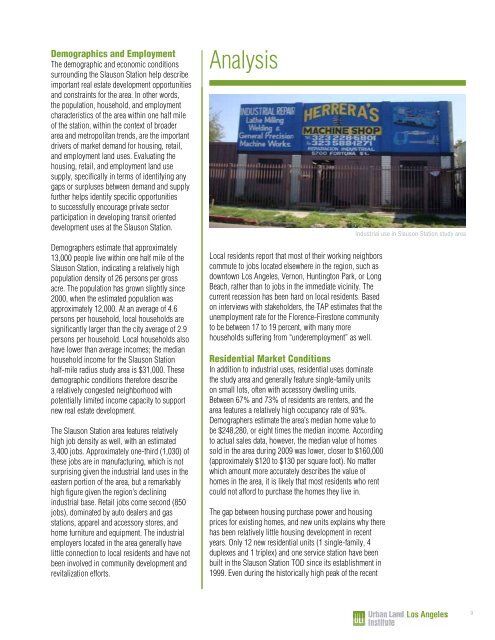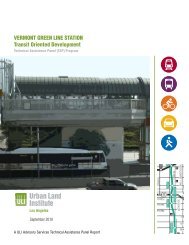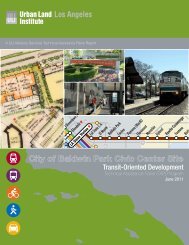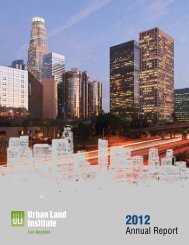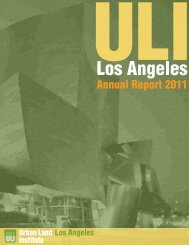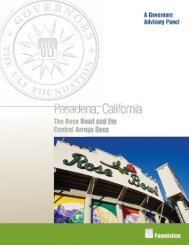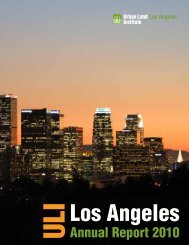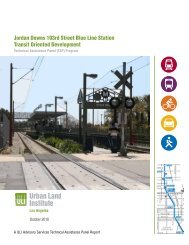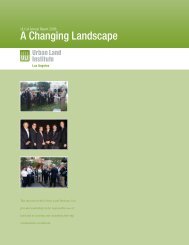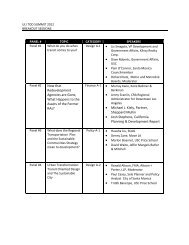Slauson Station - ULI Los Angeles - Urban Land Institute
Slauson Station - ULI Los Angeles - Urban Land Institute
Slauson Station - ULI Los Angeles - Urban Land Institute
Create successful ePaper yourself
Turn your PDF publications into a flip-book with our unique Google optimized e-Paper software.
Demographics and Employment<br />
The demographic and economic conditions<br />
surrounding the <strong>Slauson</strong> <strong>Station</strong> help describe<br />
important real estate development opportunities<br />
and constraints for the area. In other words,<br />
the population, household, and employment<br />
characteristics of the area within one half mile<br />
of the station, within the context of broader<br />
area and metropolitan trends, are the important<br />
drivers of market demand for housing, retail,<br />
and employment land uses. Evaluating the<br />
housing, retail, and employment land use<br />
supply, specifically in terms of identifying any<br />
gaps or surpluses between demand and supply<br />
further helps identify specific opportunities<br />
to successfully encourage private sector<br />
participation in developing transit oriented<br />
development uses at the <strong>Slauson</strong> <strong>Station</strong>.<br />
Demographers estimate that approximately<br />
13,000 people live within one half mile of the<br />
<strong>Slauson</strong> <strong>Station</strong>, indicating a relatively high<br />
population density of 26 persons per gross<br />
acre. The population has grown slightly since<br />
2000, when the estimated population was<br />
approximately 12,000. At an average of 4.6<br />
persons per household, local households are<br />
significantly larger than the city average of 2.9<br />
persons per household. Local households also<br />
have lower than average incomes; the median<br />
household income for the <strong>Slauson</strong> <strong>Station</strong><br />
half-mile radius study area is $31,000. These<br />
demographic conditions therefore describe<br />
a relatively congested neighborhood with<br />
potentially limited income capacity to support<br />
new real estate development.<br />
The <strong>Slauson</strong> <strong>Station</strong> area features relatively<br />
high job density as well, with an estimated<br />
3,400 jobs. Approximately one-third (1,030) of<br />
these jobs are in manufacturing, which is not<br />
surprising given the industrial land uses in the<br />
eastern portion of the area, but a remarkably<br />
high figure given the region’s declining<br />
industrial base. Retail jobs come second (850<br />
jobs), dominated by auto dealers and gas<br />
stations, apparel and accessory stores, and<br />
home furniture and equipment. The industrial<br />
employers located in the area generally have<br />
little connection to local residents and have not<br />
been involved in community development and<br />
revitalization efforts.<br />
Analysis<br />
Local residents report that most of their working neighbors<br />
commute to jobs located elsewhere in the region, such as<br />
downtown <strong>Los</strong> <strong>Angeles</strong>, Vernon, Huntington Park, or Long<br />
Beach, rather than to jobs in the immediate vicinity. The<br />
current recession has been hard on local residents. Based<br />
on interviews with stakeholders, the TAP estimates that the<br />
unemployment rate for the Florence-Firestone community<br />
to be between 17 to 19 percent, with many more<br />
households suffering from “underemployment” as well.<br />
Residential Market Conditions<br />
In addition to industrial uses, residential uses dominate<br />
the study area and generally feature single-family units<br />
on small lots, often with accessory dwelling units.<br />
Between 67% and 73% of residents are renters, and the<br />
area features a relatively high occupancy rate of 93%.<br />
Demographers estimate the area’s median home value to<br />
be $248,280, or eight times the median income. According<br />
to actual sales data, however, the median value of homes<br />
sold in the area during 2009 was lower, closer to $160,000<br />
(approximately $120 to $130 per square foot). No matter<br />
which amount more accurately describes the value of<br />
homes in the area, it is likely that most residents who rent<br />
could not afford to purchase the homes they live in.<br />
The gap between housing purchase power and housing<br />
prices for existing homes, and new units explains why there<br />
has been relatively little housing development in recent<br />
years. Only 12 new residential units (1 single-family, 4<br />
duplexes and 1 triplex) and one service station have been<br />
built in the <strong>Slauson</strong> <strong>Station</strong> TOD since its establishment in<br />
1999. Even during the historically high peak of the recent<br />
Industrial use in <strong>Slauson</strong> <strong>Station</strong> study area<br />
9


